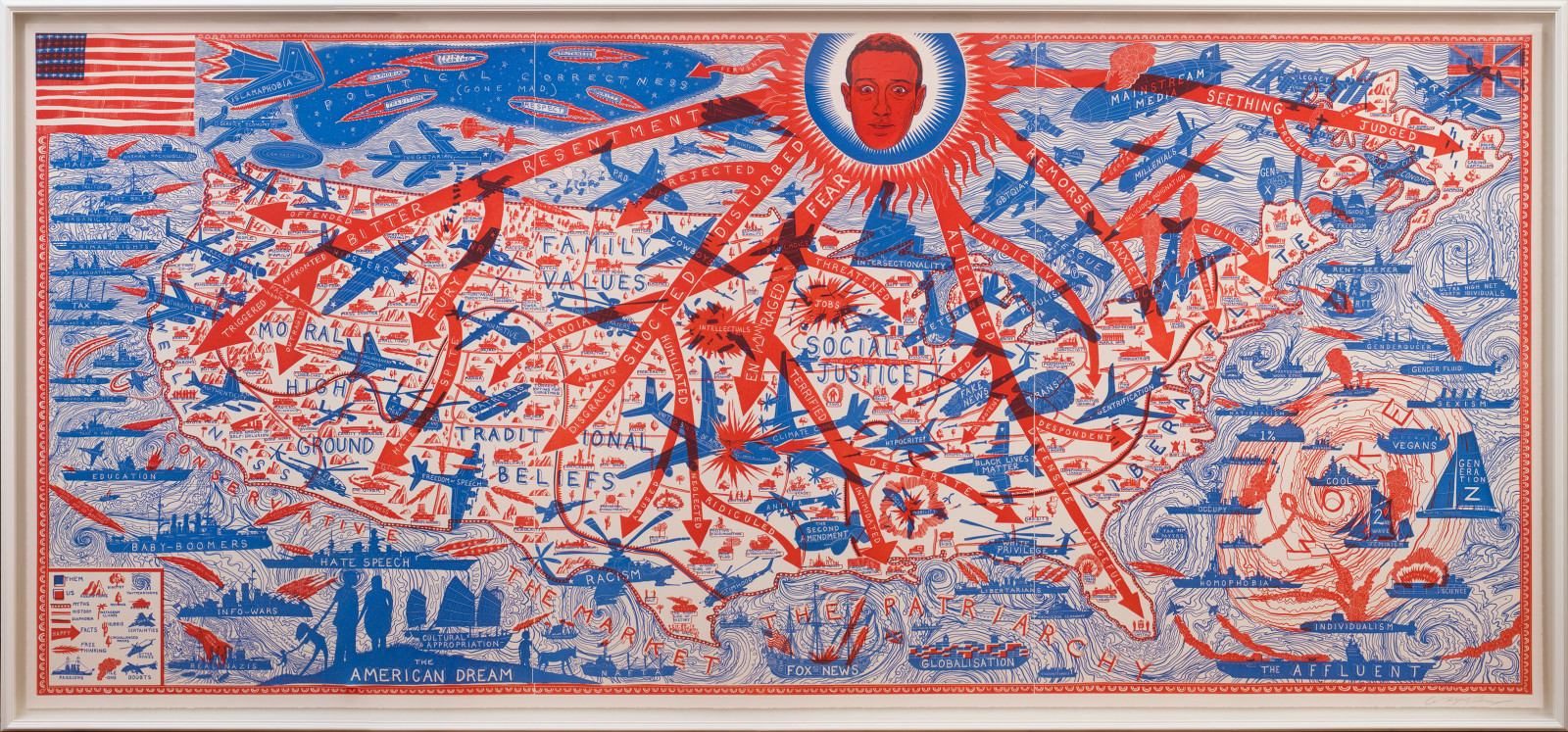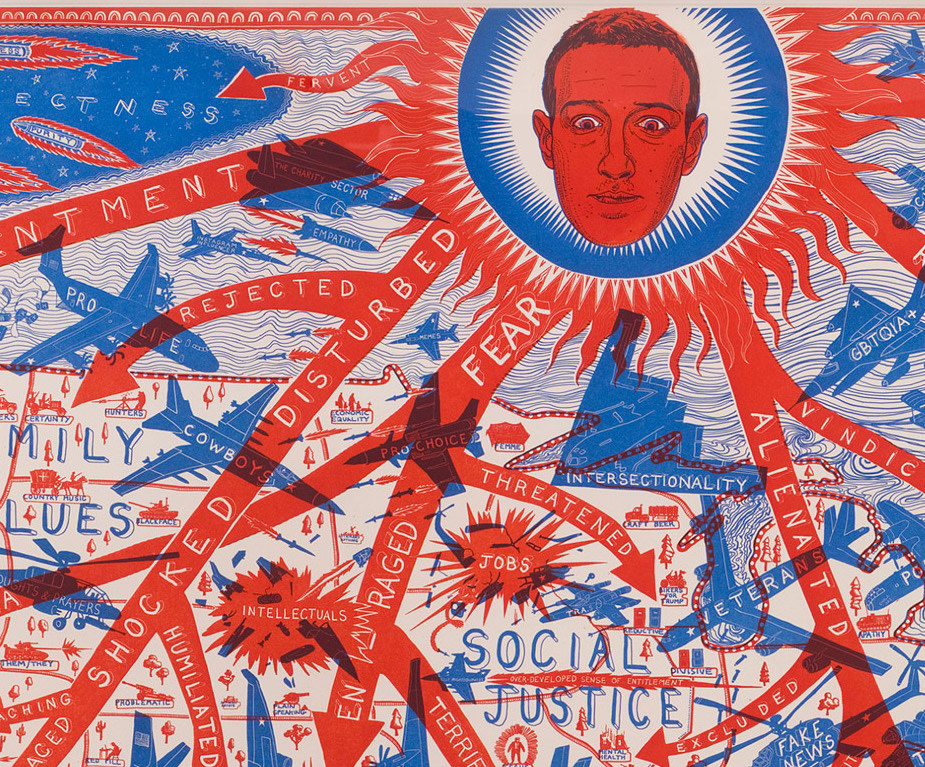Piano Nobile’s new exhibition Grayson Perry: Ceramics and Prints includes two examples of the artist’s map-like works. InSight considers the origins and iconography of this theme in Perry’s work.
Grayson Perry (b. 1960) started making prints shortly after winning the Turner Prize in 2003.
I had never thought of making prints until I was at a friend’s house and saw a print by an artist who’d drawn a map of the world from memory. It was a large etching in a glass frame and I really liked it as an object. I realized that this was a subset of objects that I was interested in: something on a domestic scale with a long tradition, like those framed maps of counties that posh houses often have in their loos.
Perry’s parodic adaptation of maps like those of John Speed lies at the root of his activities as a print-maker. Since producing Map of an Englishman in 2004, he has continued to deploy the cartographic format in various guises, from the Map of Nowhere in 2008, through Map of Truths and Beliefs in 2011 and A Map of Days in 2013, to The American Dream in 2020.


Through his schizophrenic word clouds, with place names displaced by laddish argot and tabloid jargon, some of Perry’s map prints combine the formula of medieval mappa mundi with early modern imagery from the generation of Dürer and Grunewald. In Map of Nowhere, Perry himself replaces Christ as the central figure, grafted onto the regular cartography of land masses, lakes and rivers; his gesture is adapted from that of John the Evangelist in Grunewald’s Isenheim Altarpiece. The subject of Perry’s print alludes to Thomas More’s coinage, Utopia, a Latin word meaning ‘nowhere place’, though this updated version strips away the idealism of More’s perfect commonweal. As with much of Perry’s work, the complexity of the piece comes from its combination of many different and unexpected sources – an accumulation which speaks of both the artist’s skill and his vision.


Beginning with the use of text in his early ceramic works of the 1980s and ‘90s, Perry has emerged as one of the most incisive interpreters of the contemporary art world. Mixing political savvy and an instinctual distrust of ‘high art’, the artist has originated his own unique form of allegory. The key components of Perry’s modern-day allegories are parodic adaptations of historical source material, pointed allusions to current affairs, and an unapologetically of-the-moment lexicon (hence references in Map of Nowhere to ‘casino capitalism’ and ‘trendy wine bar’). The mixture is further enriched with reference to qualities like confidence, talent and luck, which were historically considered the proper subjects for allegory.

In 2017, Perry made his first map-based tapestry, which was included in a solo exhibition at the Serpentine Gallery in Hyde Park, The Most Popular Art Exhibition Ever! So popular was the exhibition that many visitors ironically found themselves queueing to get in. (Some mistakenly believed the queue to be a simulated extension of the exhibition, designed to reiterate the show’s popularity, only to discover an overcrowded gallery space upon entry.) The exhibition displayed Perry’s imaginative use of maps to illustrate politically contentious issues. In the case of Red Carpet, a map of the British Isles was inscribed with loaded vocabulary like ‘us’ (outside London) and ‘them’ (in London), Devon and Cornwall were labelled ‘the real world’ along with a smaller textbox indicating the presence of ‘second homes’, and many other phrases floated free of geographical referents, including ‘right to buy’, ‘affordable homes’, ‘gated community’ and ‘postcode lottery’.


Though artists often avoid currency for fear of their art aging badly, in this respect Grayson Perry seems fearless. His most recent map-like print, The American Dream, satirises the state of US politics under Donald Trump by inscribing topical vocabulary onto a variety of military aircraft, from drones and fighter jets to the unexpected appearance of the Millennium Falcon, courtesy of the Star Wars franchise. The chaotic scene is surveyed by the God-like face of Mark Zuckerberg, the founder and CEO of Facebook, which emanates angry, tentacular arrows – the effects of social media – labelled ‘fear’, ‘resentment’, and so on.


Perry is more observant than opinionated. These map-like word-clouds reflect the landscapes of culture and politics, giving an outline of contemporary discussions without making declarations of right or wrong. As an artist, he has an aversion to normative thinking, though undoubtedly he enjoys taking the side of transgression. While the issues that Perry addresses are controversial, the resulting work is far from it. Rather than being querulous or offensive, pieces like Map of Nowhere, Red Carpetand The American Dream are thoughtful, articulate, and pleasingly colourful.


